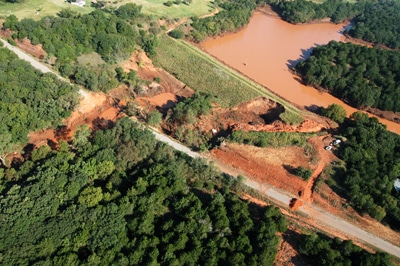OCC and OWRB Collaborate on Dam Breach Inundation Study
A study completed by the Conservation Commission and Water Board on keeping dams safe includes recommendations for funding and changes to Oklahoma Dam Safety Rules.

Nearly 200 dams in the state have been designated as more hazardous to public safety than when they were built because of development downstream in the intervening years. And the number of dams that could have the same fate continues to grow. A group selected to study the situation has completed a report, making recommendations intended to save the state millions of dollars spent to modify a growing number of dams that could possible receive that high hazard classification.
With over 2,100 flood control dams (watershed dams) in the state, Oklahoma is a national leader in the USDA Small Watershed Upstream Flood Control Program. In the 50-plus years since the watershed dams were built, residential and business development in the dams’ breach inundation areas has resulted in 199 of them to be reclassified as high hazard. The breach inundation area is the area downstream from the dam that would likely be inundated if the dam were to fail. A dam is classified as high-hazard if a loss of life may be likely if the dam should fail. With homes and businesses being built downstream from these dams, the number of watershed dams being reclassified to high hazard is increasing each year. The average cost estimate for modifying a watershed dam to meet safety criteria is $1,000,000.
House Bill 1884, passed by the state Legislature and enacted on April 27, 2009, directed the Oklahoma Water Resources Board (OWRB) and the Oklahoma Conservation Commission (OCC) to establish a study group composed of members selected by OWRB and OCC for the purpose of how to reduce the increasing number of dams being reclassified to high hazard. The study group completed its work and submitted a final report on Dec. 22, 2009.
The goals of the group were to:
1. Review laws and regulations pertaining to the classification of high-hazard dams.
2. Make recommendations to reduce the future number of low- or significant-hazard dams that are reclassified as high-hazard.
3. Form a plan to inform the public and officials on safety risks associated with the construction of residences or businesses downstream of or adjacent to low- or significant-hazard dams; and
4. Explore funding sources and options for the upkeep and rehabilitation of dams in the state and for the mapping of breach inundation areas downstream of dams.
The findings and recommendations were grouped into categories of Legal, Funding, Education and Mapping.
Legal
The report recommends revisions to Oklahoma Dam Safety Act to relieve the urgent demand for costly dam safety modifications for some low priority dams if mechanisms for public safety — such as warning mechanisms and evacuation plans — are in place. The group recommended that OWRB make those revisions and also allow for variances to be granted contingent on public health and safety mechanisms. The group encourages that any revisions to the rules ensure continued public safety and not interfere with the state’s ability to qualify for and receive federal dam safety and rehabilitation funding.
Funding
In addition to state appropriations, there are a few potential federal funding sources to help pay for mapping the breach inundation areas of low and significant hazard dams. One is the USDA Natural Resources Conservation Service’s Watershed Rehabilitation Program that is currently being used to map high-hazard dams. In the Department of Homeland Security the Flood Mitigation Assistance, Pre-Disaster Mitigation, and Map Modernization Management Support programs are potential funding sources. The group suggested that the issue of seeking more federal funding be communicated to Oklahoma’s Congressional Delegation for setting as a priority. State legislative actions were also suggested, such as charging fees for permits to build in breach inundation areas.
Education
The study group found that limited existing educational materials are available regarding the potential hazards for public safety and buildings in dam breach inundation areas. It concluded that targeted audiences and key organizations could be identified to implement an education plan. The group recommended that existing funding be utilized to the extent possible to create and distribute materials until a long-term plan is developed to detail materials, strategies, budgets and schedules.
Mapping
The group recommended that uniform mapping standard and methodology currently in use by the USDA Natural Resources Conservation Service be adopted. The report concluded that it produces reasonable, conservative breach inundation maps in a timely manner. It would require significant human and financial resources to map breach inundation areas of all low and significant hazard dams in the state, but at best it would be a fraction of the cost of upgrading the dams to meet high hazard dam safety requirements. The group recommended that OWRB, OCC and NRCS together formally adopt a uniform and consistent methodology to map the breach inundation areas of the NRCS-assisted low and significant hazard dams in the state and that the Oklahoma Legislature appropriate the necessary funding to pay for it.
